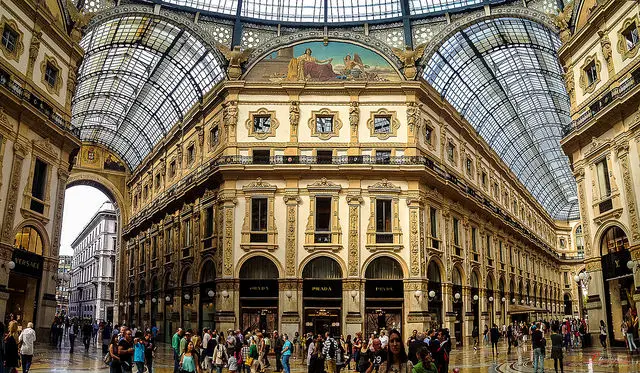Italy’s fashion industry expected to continue the lead

Known as the historical home of the majority of luxury houses, Europe’s market accounts for nearly $83 billion of the personal luxury goods sector, according to a report by R&S Mediobanca.
The annual “Italian Fashion Sector” survey looks at Italy’s key industry, with a focus on the top 15 fashion houses that call the country home. Italy’s successes in the luxury category have assisted the Italian economy during its stagnant economic situation and have propelled all of Europe to a hub for tourism-based purchasing, making the continent the number one market in the world.
The analysis looks at the 143 top fashion companies based in Italy that recorded a turnover of at least Euro 100 million in 2014. It also focuses on the 15 biggest groups in the world of fashion, the Top 15 Fashion brands. The financial statements of each company from 2010 to 2014 as well as the first nine months of 2015 were reviewed for the survey. Brands and groups seen in the top 15 include Luxottica, Prada, Giorgio Armani, OTB, Salvatore Ferragamo, Ermenegildo Zegna, Safilo Group, Dolce & Gabbana and Tod’s, among others.
The results from the survey position Europe as central to the luxury marketplace in comparison to the rest of the world, with spending in the European fashion sector linked to tourism. Compared to other markets, Europe wins out in terms of exports and attractiveness for foreigners to visit and to shop while visiting.
Studies have shown that Europe’s strong financial structure is to the fashion industry, and by the market growth of Italian luxury.
The survey finds that the personal luxury goods sector generates $264 billion in revenue, a 2 percent increase from 2013. At the heart of the industry is Europe, with $83 billion, and the Americans with $79 billion.
Although many in the luxury space spend ample time positioning their brands in Asia-Pacific, the market places third with only $51 billion. Likewise, Japan spends $19 billion on luxury goods. This difference in market revenue when compared to Europe and the Americas is connected to consumers from these regions preferring to shop abroad to escape import taxes and higher prices within their home country.
Tax-free travel retail is expected to increase by 26 percent and 19 percent in Europe and Italy, respectively.
As expected, e-commerce is continuing to grow, with online sales increasing 40 percent in 2015. In regards to luxury, the industry is estimated to grow by two percentage points over its current value of 5 percent.
Brands within the top 15 saw a 12.3 percent increase in their earnings before interest and tax (EBIT) margin compared to mass fashion companies based in Italy. Likewise, the top 15 have a return on equity (ROE) that is greater than their mass peers.
Additionally, the survey found that the top 15 brands saw the most substantial growth. Progress was marked by a 30.8 percent increase from $23.4 billion in 2010 to $30.6 billion in 2014.
R&S Mediobanca cites Prada as a case study, as the apparel and accessories house saw the fastest growth of the top 15 with a 73.5 percent increase since 2010.
R&S Mediobanca found that Prada saw the fastest growth of the top 15 brands with a 73.5 percent increase since 2010. Prada was followed by Ferragamo, which grew 70.8 percent in the same time frame.
Eyewear manufacturer Luxottica came out above its top 15 peers with $8.428 million in revenue for 2014. Luxottica’s earnings puts it above Prada with $3.911 million and Armani at $2.791 million.
The foreign market accounted for 60.1 percent of the Italian fashion sector’s total turnover in 2014. This was further accentuated by the brands found in the top 15 grouping, mainly those dealing in eyewear and leather goods. The eyewear and leather goods category accounted for 90.2 percent and 70.1 percent of turnover, respectively.
Luxury brands are struggling to lure talent that is qualified to work in its workshops, as the traditional jobs associated with high-end goods craftsman, from watches to leather goods, is no longer appealing to the younger generations.
While talent retention has become a problem within the industry, luxury houses remain an attractive employer for many within in Italy. Not only among traditional positions such as designers, management, etc., but also in part to the increase in social media marketing that fashion brands are embracing.
The report found that Italy’s fashion workforce is growing with employment increasing by 22.7 percent, or 58,000 jobs. By 2014, the number of employees in the Italian fashion workforce totaled 316,000.
Italian brands hired 24.2 percent more workers compared to 16.1 percent of foreign-owned companies. Within the top 15, the leading brands hired an additional 45,000 employees, an increase of 34.2 percent compared to 2010.
Brands with the largest hirings, accounting for 81 percent of all hires among the top 15, include Luxottica with more than 14,000 new employees, Prada with 4,763 and Armani with 2,845.
In all, the future remains bright for Italian fashion brands leading the industry.
The complete survey can be downloaded from www.mbres.it